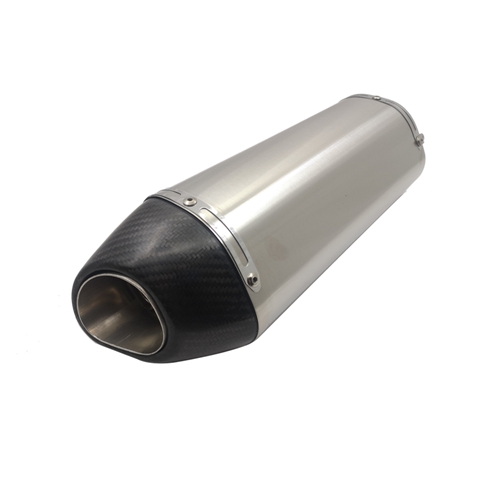Changing your Motorcycle Exhaust is one of the most common upgrades riders consider — it can improve performance, reduce weight, and change the sound of the bike. However, you cannot simply install any exhaust system without checking for compatibility, safety, and legal requirements. The right exhaust must fit your motorcycle’s engine type, fuel mapping, and emission standards. Below is a detailed explanation of what to consider before replacing your exhaust.

Every motorcycle exhaust is designed for a specific engine layout and displacement. The exhaust system controls how gases exit the combustion chamber, which directly affects power delivery and engine efficiency.
Installing an incompatible exhaust can lead to:
Poor fuel combustion and power loss.
Engine overheating or backfiring.
Increased emissions and potential legal issues.
To ensure compatibility, check the manufacturer’s fitment list or choose a system designed for your specific make and model.
Different exhaust configurations serve different performance goals. Knowing these helps you choose correctly.
| Exhaust Type | Description | Ideal For |
|---|---|---|
| Slip-On Exhaust | Replaces only the muffler section while retaining the stock headers. | Riders who want better sound and moderate weight reduction. |
| Full System Exhaust | Replaces the entire exhaust system from headers to muffler. | Performance tuning and racing applications. |
| High-Mount or Low-Mount Exhaust | Changes the position of the muffler for clearance or aesthetics. | Off-road or sport bikes needing specific fitment. |
| Dual Exhaust | Two mufflers working in parallel for multi-cylinder engines. | Larger bikes with V-twin or inline-four engines. |
Not all systems can be interchanged — fitment depends on engine layout, exhaust routing, and mounting brackets.
In many regions, exhaust systems are regulated to control noise and pollution levels.
Street-legal exhausts include catalytic converters and meet emission standards.
Race or performance exhausts often remove catalytic elements, making them unsuitable for road use.
Before purchasing, look for certification markings such as:
EPA or DOT compliance (U.S.)
E-mark or EC approval (Europe)
Installing a non-compliant exhaust may lead to fines, failed inspections, or voided warranties. Always confirm local regulations before modification.
Aftermarket exhausts can change the air-to-fuel ratio of the engine. If you install a high-flow exhaust without proper tuning, the bike may run lean — causing overheating and reduced performance.
Upgrading to a full system exhaust.
Removing the catalytic converter or adding a free-flow muffler.
Installing an exhaust on a fuel-injected motorcycle.
Use a fuel controller or ECU remap to correct fueling.
Rejet carburetors on older bikes for balanced air-fuel delivery.
Proper tuning ensures smoother throttle response, lower exhaust temperatures, and improved horsepower.
Motorcycle exhausts come in various materials that influence both performance and appearance.
| Material | Characteristics | Best Use |
|---|---|---|
| Stainless Steel | Corrosion-resistant and affordable. | Everyday commuting and touring. |
| Titanium | Lightweight, high strength, premium finish. | Sport and performance motorcycles. |
| Carbon Fiber | Heat-resistant and stylish but fragile under impact. | Show or racing bikes. |
| Mild Steel | Cheap but prone to rust without coating. | Budget builds or classic restorations. |
While materials can be mixed and matched, the pipe diameter and collector design must match the engine’s exhaust pressure needs.
If you plan to install an exhaust yourself, follow these basic guidelines:
Check clearance: Ensure no contact with the swingarm, footpegs, or fairings.
Use new gaskets: Replace all old exhaust seals to prevent leaks.
Torque fasteners correctly: Over-tightening can warp flanges or crack joints.
Inspect alignment: The pipe should run parallel to the frame and clear heat-sensitive components.
Test run after installation: Start the engine and listen for unusual noises or exhaust leaks.
Professional installation is recommended for full systems or when ECU tuning is required.
Some riders install any exhaust purely for sound without understanding its effect. You should avoid swapping exhausts when:
The engine is under warranty and modifications may void coverage.
Your region enforces strict emission testing.
The replacement exhaust lacks baffles or catalytic converters.
You do not plan to adjust the fuel system after installation.
In these cases, stick with an approved slip-on or OEM-compatible upgrade.
You can’t put just any exhaust on a motorcycle — it must be designed for your bike’s engine configuration and meet local regulations.
Choose between slip-on or full systems based on your goals, ensure correct fuel tuning, and confirm legal compliance before installation.
With the right setup, an aftermarket exhaust can provide better sound, improved performance, and reduced weight, transforming your riding experience safely and effectively.
Previous: Can I Paint My Motorcycle Exhaust?